

Dendrochronology. Drill for dendrochronology sampling and growth ring counting The growth rings of a tree at Bristol Zoo, England.
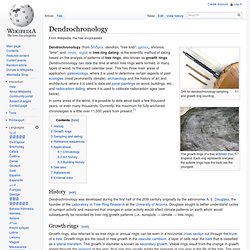
Each ring represents one year; the outside rings, near the bark, are the youngest. Dendrochronology (from δένδρον, dendron, "tree limb"; χρόνος, khronos, "time"; and -λογία, -logia) or tree-ring dating, is the scientific method of dating based on the analysis of patterns of tree rings, also known as growth rings. Dendrochronology can date the time at which tree rings were formed, in many types of wood, to the exact calendar year. This has three main areas of application: paleoecology, where it is used to determine certain aspects of past ecologies (most prominently climate); archaeology and the history of art and architecture, where it is used to date old panel paintings on wood, buildings, etc.; and radiocarbon dating, where it is used to calibrate radiocarbon ages (see below).
Erdős–Bacon number. A person's Erdős–Bacon number is the sum of one's Erdős number—which measures the "collaborative distance" in authoring mathematical papers between that person and Hungarian mathematician Paul Erdős—and one's Bacon number—which represents the number of links, through roles in films, by which the individual is separated from American actor Kevin Bacon.[1][2] The lower the number, the closer a person is to Erdős and Bacon, which reflects a small world phenomenon in academia and entertainment.[3] In general, to have a defined Erdős–Bacon number, it is a necessary (but not a sufficient) condition for one to have both appeared in a film and co-authored an academic paper.
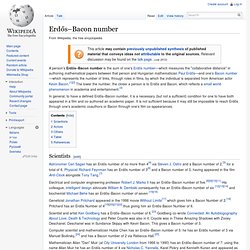
It is not sufficient because it may still be impossible to reach Erdős through one's academic coauthors or Bacon through one's film co-appearances. Scientists[edit] Electrical and computer engineering professor Robert J. Solresol. Solresol is a constructed language devised by François Sudre, beginning in 1827.
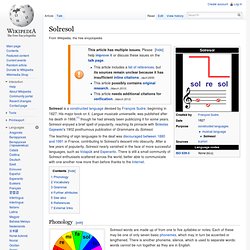
His major book on it, Langue musicale universelle, was published after his death in 1866,[1] though he had already been publicizing it for some years. Solresol enjoyed a brief spell of popularity, reaching its pinnacle with Boleslas Gajewski's 1902 posthumous publication of Grammaire du Solresol. The teaching of sign languages to the deaf was discouraged between 1880 and 1991 in France, contributing to Solresol's descent into obscurity.
Space fountain. The Hyde design for a space fountain History[edit] Robert L.
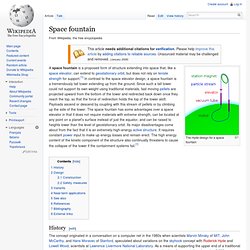
Forward joined the conversation at this point, suggesting that instead of using a pellet stream to support the top of a traditional tensional cable, a vertical pellet stream shot straight up from Earth's surface could support a station and provide a path for payloads to travel without requiring a cable at all. Problems that were initially raised with this proposal were friction of the pellet stream with Earth's atmosphere at lower altitudes and the Coriolis forces due to the rotation of the Earth, but Roderick Hyde worked out all the engineering design details for a space fountain and showed that these issues could theoretically be overcome.[1] Design[edit] The space fountain acts as a continuous coil gun with captive projectiles travelling in a closed loop.
As the projectiles travel back down the tower they are accelerated by coil guns that use the electrical energy extracted from the upgoing stream of projectiles. Immortal Game. Game animation General description[edit] Checkmate of the Immortal Game Adolf Anderssen was one of the strongest players of his time, and many consider him to have been the world's strongest player after his victory in the London 1851 chess tournament.
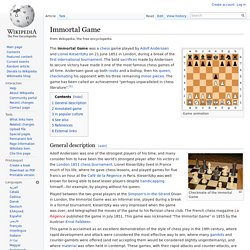
Lionel Kieseritzky lived in France much of his life, where he gave chess lessons, and played games for five francs an hour at the Café de la Régence in Paris. Kieseritzky was well known for being able to beat lesser players despite handicapping himself—for example, by playing without his queen. Played between the two great players at the Simpson's-in-the-Strand Divan in London, the Immortal Game was an informal one, played during a break in a formal tournament. Original 57 merit badges (Boy Scouts of America) In 1911, 57 merit badges were issued by the Boy Scouts of America.
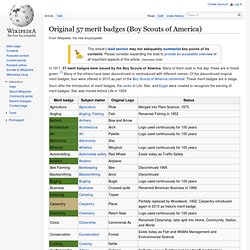
Many of them exist to this day; these are in forest green. [1] Many of the others have been discontinued or reintroduced with different names. Of the discontinued original merit badges, four were offered in 2010 as part of the Boy Scouts of America centennial. These merit badges are in beige. Jump up ^ Duersch Jr., Fred (2003). Merit Badge Field Guide. Clairvius Narcisse. Clairvius Narcisse (born c. 1922) is a Haitian man said to have been turned into a living zombie by a combination of drugs.
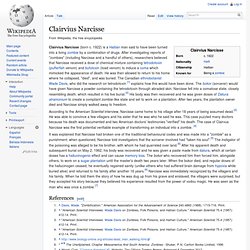
After investigating reports of "zombies" (including Narcisse and a handful of others), researchers believed that Narcisse received a dose of chemical mixture containing tetrodotoxin (pufferfish venom) and bufotoxin (toad venom) to induce a coma which mimicked the appearance of death. He was then allowed to return to his home where he collapsed, "died", and was buried. The Canadian ethnobotanist Wade Davis, who did the research on tetrodotoxin [1] explains how this would have been done.
The bokor (sorcerer) would have given Narcisse a powder containing the tetrodotoxin through abraded skin. Narcisse fell into a comatose state, closely resembling death, which resulted in his live burial.[2] His body was then recovered and he was given doses of Datura stramonium to create a compliant zombie-like state and set to work on a plantation. Jump up ^ Davis, Wade.